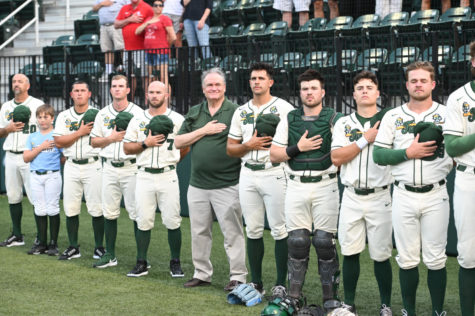Riptide’s Reflections | What’s next for Tulane baseball?
June 7, 2023

Riptide’s Reflections is The Tulane Hullabaloo’s column talking all things Tulane athletics.
As the baseball season ends, Tulane University is left with more questions than answers. On the one hand, the Green Wave had a historically bad season where the team finished 19-42 and simply played bad baseball at times. At the same time, the team won the American Athletic Conference tournament and made the postseason for the first time in seven years.
It is worth examining some of these questions in order to see what the state of the team might be next season. For analysis purposes, I will assume most players will not leave the program via the transfer portal or the MLB Draft due to the difficulty of predicting both. However, Tulane will inevitably lose players due to these factors.
The pitching staff was a mixed bag last season with little certainty about the future. Dylan Carmouche will headline the rotation and start Friday nights. Luc Fladda should replace Ricky Castro, who is out of eligibility, as the Saturday starter. Fladda, an incoming transfer from Johnson County Community College, had a stellar year at the Junior College level as he was a member of the all-conference team. He held a record of 12-0 in 17 starts with an ERA of 2.74 which included six complete games.
Behind those two, who will be the Sunday and midweek starter? Chandler Welch, Jonah Wachter and Cristian Sanchez all held one of these spots this season. However, Welch and Wachter seem to operate better as long relievers rather than starters while Sanchez was ineffective for most of the year.
Other options include Michael Lombardi and Billy Price. Lombardi is one of the best pitchers on the team and coach Jay Uhlman has said that he could be a potential starter down the line. Price was recovering from injury entering this season, but ideally in full health, he could be in the conversation as a traditional starter.
Then comes the question of the bullpen. Michael Fowler will be the team’s closer while Gavin Smith is a good high leverage reliever. But there are a host of unknowns. How good can older relievers such as Tayler Montiel and Blake Mahmood be? Can Tulane’s four freshmen pitchers take the steps forward needed by the team?
Freshmen pitchers Lombardi, Colin Reilly, Grant Cleavinger and Will Prigge will all need to take big steps in their development but have potential. All four struggled with command at times but both Reilly and Cleavinger can produce strikeouts. Meanwhile, Prigge was injured for most of the season but does possess a very good breaking ball.
There are questions across the diamond as well. Both starting catchers, Brennan Lambert and Seth Beckstead graduated, but could they stay for another year due to COVID-19 granting extra eligibility? If they leave, the only other catcher on the roster is Reed Kellum, who did not see much playing time this year. The same question could be asked about third baseman Simon Baumgardt, infielder Brayden Morrow and outfielder Brady Hebert.
First baseman Brady Marget was a bright spot this season and emerged as arguably the team’s best pure hitter.
However, the middle infield is more murky. Gavin Schulz and James Agabedis III held down these two positions this year and both were solid defenders. Schulz is a solid defender and hit .242 last year with an on-base percentage of .377. It’s certainly not bad, but Tulane will probably need a little bit more offensively from him.
Meanwhile, Agabedis is one of the best defenders on the team, but the freshman batted .150 on the year. At the high school level in Massachusetts, he hit .386. This discrepancy may be a matter of adjusting to Division I pitching rather than a talent issue. It would not be surprising if he takes the biggest leap forward out of anybody on the team.
In the outfield, Teo Banks, Jackson Linn and Jacob LaPrairie all saw significant playing time. Banks was one of the most impressive hitters on the team, especially down the stretch. LaPrairie was a solid middle of the order batter, hitting .263 with an on-base percentage of .376. Both are prone to the occasional misplayed ball in the outfield but are otherwise solid defenders.
Linn went from one of the best young talents in college baseball in 2022 to a player who struggled to hit over .200. At the end of the 2022 season, he tore his UCL — an injury that takes a notoriously long time to heal. While not all of his struggles are due to the injury, it undoubtedly affected his ability to play at a high level. The hope is that he can have a strong bounce back campaign in 2024, as he has shown the talent to be a special player.
Other potential players in the outfield mix are Ben Romano and Brock Slaton. Romano redshirted this season at Tulane but hit .431 in high school, which led him to be ranked as the third best outfielder in New Jersey by Perfect Game. Slaton is an incoming transfer from Delgado Community College. For the Dolphins last season, he hit .325 with 11 home runs.
This leaves the question of what impact the incoming freshman class will have on the team? Perfect Game lists 14 players in Tulane’s next class with half the class from Louisiana. Among them is two-way player William Good, who was the starting pitcher for the state championship game when his Jesuit High School Blue Jays beat the Archbishop Rummel High School Raiders 1-0. Good, as well as fellow Tulane commit Steven Spalitta, both made the Louisiana Baseball Coaches Association All-State team.
The last question is perhaps the most important on the minds of Tulane fans: how long until this team returns to its former glory? Realistically, the answer is still several years away, which is true regardless of the events of this season. Still, it is important to remember that the core of the team is still young and that its players will improve drastically. Nevertheless, the program is starting to look like it could build something special here if given the chance.








Leave a Comment